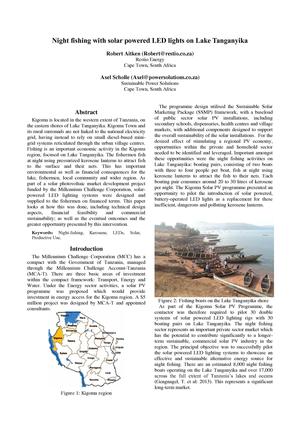Knowledge fuels change - Support energypedia!
For over 10 years, energypedia has been connecting energy experts around the world — helping them share knowledge, learn from each other, and accelerate the global energy transition.
Today, we ask for your support to keep this platform free and accessible to all.
Even a small contribution makes a big difference! If just 10–20% of our 60,000+ monthly visitors donated the equivalent of a cup of coffee — €5 — Energypedia would be fully funded for a whole year.
Is the knowledge you’ve gained through Energypedia this year worth €5 or more?
Your donation keeps the platform running, helps us create new knowledge products, and contributes directly to achieving SDG 7.
Thank you for your support, your donation, big or small, truly matters!
Night Fishing with Solar Powered LED Lights on Lake Tanganyika
Night Fishing with Solar Powered LED Lights on Lake Tanganyika
Presenter: Robert Aitken, (Restio Energy, South Africa)
Rapporteurs: Jonathan Lee and Carmen Iten
Overview
| Kigoma is located in the western extent of Tanzania, on the eastern shores of Lake Tanganyika. Kigoma Town and its rural surrounds are not linked to the national electricity grid, having instead to rely on small diesel-based mini-grid systems reticulated through the urban village centres. Fishing is an important economic activity in the Kigoma region, focused on Lake Tanganyika. The fishermen fish at night using pressurized kerosene lanterns to attract fish to the surface and their nets. This has important environmental as well as financial consequences for the lake, fishermen, local community and wider region. As part of a solar photovoltaic market development project funded by the Millennium Challenge Corporation, solar-powered LED lighting systems were designed and supplied to the fishermen on financed terms. This paper looks at how this was done, including technical design aspects, financial feasibility and commercial sustainability; as well as the eventual outcomes and the greater opportunity presented by this intervention[1]. |
Issues Presented
► Please see the presentation.
- There needs to be an emphasis on maintenance in off-grid electrification projects, specifically the battery
- Study investigates kerosene lighting replacement for night fishing in the remote area of Kigoma, Tanzania
- The study looked at costs and compares how much they fish with LED lights compared to normal kerosene lamps. However, the fishing patterns are fairly unpredictable therefore it is difficult to compare.
- Significant market in Kigoma – 50% of earnings come from fishing
- $600-$800 partially subsidized systems. All 30 offered were sold.
- Approximate net annual savings of $3100 over 5 years from fuel
- The system introduced in this study was a bit oversized.
- The study looked at costs and compares how much they fish with LED lights compared to normal kerosene lamps. However, the fishing patterns are fairly unpredictable therefore it is difficult to compare.
Q & A
1. What are the barriers to adoption?
- Issue of financing on normal terms (without partial subsidy or no interest financing). Standards need to be established and enforced to ensure a reputable image as more people enter the market.
- Supply chain needs to be put in place for distribution
2. How were relationships built with consumers?
- It was difficult as many actors were involved. Essentially went through unions
3. How did you build the relationship with the fishermen?
- Through units: chairman, secretary etc.
4. Are there concerns that such a large impact on the economics of the industry might cause others to enter?
- No, a threat from commercial fishing is not expected. The industry is still a very difficult one, not one that is not expected to shift rapidly
- The presenter did not think that that will become a problem.
- Normal income is 80-250 dollars per month.
- Rebound effect might be possible since more lights increase the amount of caught fish.
References
- ↑ Night Fishing with Solar Powered LED Lights on Lake Tanganyika. Robert Aitken. Axel Scholle.





















